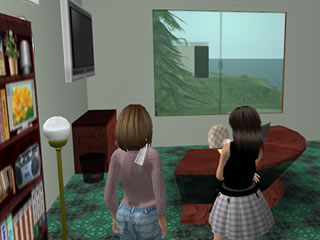| You are in the house of your host family and find an interesting piece of furniture. | ||
|
これは だれの へやですか。 | |
| わたしの へやです。 | ||
| とても きれいな へやですねえ。 | ||
| いえ、いえ。あまり きれいじゃありませんよ。 | ||
See Grammar Notes for Dialogue 3.
| 1. | だれ | who [だれの: whose] |
| 2. | へや | room |
| 3. | とても | very [modifies adjectives only; must be followed by an affirmative expression: とても きれい: very pretty/clean]] |
| 4. | きれい | pretty, beautiful [きれいな ひと "pretty person"] |
| 5. | な | [prenominal connector for な-adjective] |
| 6. | ねえ/ね | [sentence particle to express or seek agreement/confirmation] |
| 7. | いえ、いえ | No, no. ("Not at all") is a typical Japanese denial response to a compliment. |
| 8. | あまり | very [must be followed by a negative expression: あまり きれいじゃありません: not very pretty/clean] |
| 1. | うち or いえ | home, house |
| 2. | げんかん | entrance to the house |
| 3. | りょう | dormitory |
| 4. | アパート | apartment |

1. |
きれい | pretty, beautiful [きれいな ひと "pretty person"] | |||
| clean [きれいな みず "clean water"] | |||||
2. |
りっぱ | fine, splendid [りっぱな せんせい "fine teacher"] | |||
3. |
すてき | nice [すてきな とけい "nice clock/watch"] | |||
4. |
ゆうめい | famous [ゆうめいな だいがく "famous university"] | |||
5. |
しずか | quiet [しずかな へや "quiet room"] | 11. |
[にぎやか] | cheerfully noisy [にぎやかな パーティー: cheerfully noisy party] |
6. |
べんり | convenient [べんりな でんわ "convenient telephone"] | 12. |
[ふべん] | inconvenient
[ふべんな アパート: inconvenient apartment] |
7. |
[だめ] | no good [だめな ひと: no good person] ←→ いい ひと: good person] |
|||
8. |
[ひま] | not busy, idle [ひまな ひと: not busy person ←→ いそがしい ひと: busy person] |
|||
9. |
[らく] | comfortable [らくな いす: comfortable chair] | |||
10. |
[げんき] | healthy, energetic [げんきな ひと: healthy person] |
| A: | Whose room is this? |
| B: | It's mine. |
| A: | It's a very pretty room, isn't it? |
| B: | No, no, it's not that pretty. |
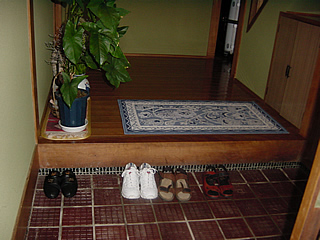 |
にほんの うち (Japanese Home) Japanese houses are much smaller than a typical American house. Another word for うち is いえ (house). Since space is limited in Japan, many universities in urban areas do not have extensive りょう (dormitories). Instead, students live off campus in an アパート(apartment) and commute to the campus. Once you get inside, you take off your shoes at げんかん (an entrance area to the house) as shown in the picture. When you take off your shoes, make sure you put them neatly together and turn them around so that the shoes face outward. |
|
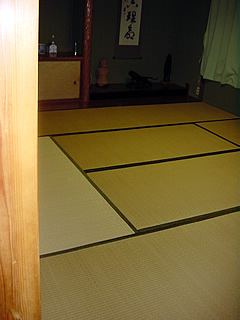 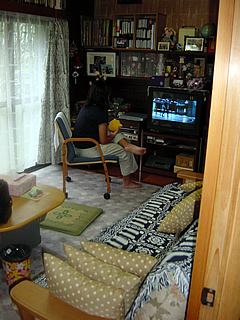 |
Most Japanese houses have both Japanese-style rooms such as the one on the left and Western-style rooms such as the one on the right. It is not unusual to see a Western-style kitchen with a dining set or a carpeted room with sofas next to the traditional Japanese room. The room on the left is a traditional Japanese-style room with たたみ mats (tightly woven straw mats). People sit on たたみ floor with a cushion and sit around a (low) table. The same room may be used differently depending on the time of the day. During the day, it may be used as a family room where people gather, watch TV, etc. At night, a bedding set called ふとん may be spread on たたみ and the room may be used as a bedroom. |
|
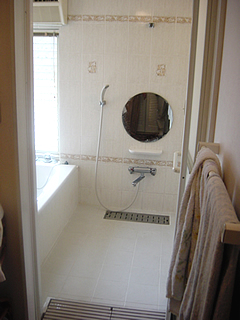 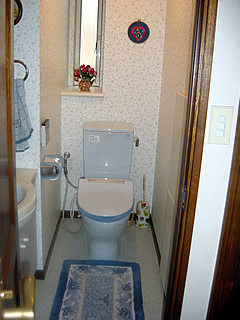 |
Bathrooms (おふろ on the left) are always kept separate from toilets (トイレ on the right). In the bathroom, you must clean your body outside of the bathtub. The bathroom is fully waterproof, so it is okay to pour water or to take shower outside of the bathtub. The water in the bathtub is shared among family members. It is used to soak your body and relax, not to clean yourself in it. It is a national obsession to keep the toilet at home as comfortable as possible. A Western-style toilet with a heated seat and remote-controlled self-cleaning system is a fairly common scene these days. |
|
